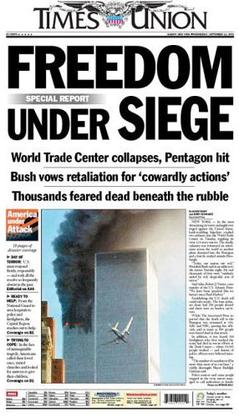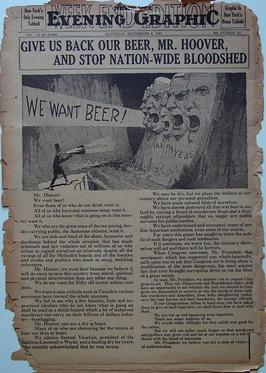
The Boston Herald is an American daily newspaper whose primary market is Boston, Massachusetts, and its surrounding area. It was founded in 1846 and is one of the oldest daily newspapers in the United States. It has been awarded eight Pulitzer Prizes in its history, including four for editorial writing and three for photography before it was converted to tabloid format in 1981. The Herald was named one of the "10 Newspapers That 'Do It Right'" in 2012 by Editor & Publisher.

A tabloid is a newspaper with a compact page size smaller than broadsheet. There is no standard size for this newspaper format.
Yellow journalism and yellow press are American terms for journalism and associated newspapers that present little or no legitimate, well-researched news while instead using eye-catching headlines for increased sales. Techniques may include exaggerations of news events, scandal-mongering, or sensationalism. By extension, the term yellow journalism is used today as a pejorative to decry any journalism that treats news in an unprofessional or unethical fashion.

Five Star Final is a 1931 American pre-Code drama film about the excesses of tabloid journalism directed by Mervyn LeRoy and starring Edward G. Robinson, Aline MacMahon and Boris Karloff. The screenplay was by Robert Lord and Byron Morgan based on the 1930 play of the same name by Louis Weitzenkorn. The title refers to the practice of newspapers publishing a series of editions throughout the day, with their final-edition front page having five stars printed and the word "Final." "Five Star Final" is also a font introduced during World War I and then favored by newspapers for its narrow type.
A gossip columnist is someone who writes a gossip column in a newspaper or magazine, especially in a gossip magazine. Gossip columns are written in a light, informal style, and relate opinions about the personal lives or conduct of celebrities from show business, politicians, professional sports stars, and other wealthy people or public figures. Some gossip columnists broadcast segments on radio and television.

Walter Winchell was a syndicated American newspaper gossip columnist and radio news commentator. Originally a vaudeville performer, Winchell began his newspaper career as a Broadway reporter, critic and columnist for New York tabloids. He rose to national celebrity in the 1930s with Hearst newspaper chain syndication and a popular radio program. He was known for an innovative style of gossipy staccato news briefs, jokes, and Jazz Age slang. Biographer Neal Gabler claimed that his popularity and influence "turned journalism into a form of entertainment".

Hedda Hopper was an American gossip columnist and actress. At the height of her influence in the 1940s, her readership was 35 million. A strong supporter of the House Un-American Activities Committee (HUAC) hearings, Hopper named suspected communists and was a major proponent of the Hollywood blacklist. Hopper continued to write gossip until the end of her life, her work appearing in many magazines and later on radio. She had an extended feud with another gossip columnist, arch-rival Louella Parsons.

Louella Parsons was an American gossip columnist and a screenwriter. She was retained by William Randolph Hearst because she had championed Hearst's mistress Marion Davies and subsequently became an influential figure in Hollywood. At her peak, her columns were read by 20 million people in 700 newspapers worldwide.

The Los Angeles Herald Examiner was a major Los Angeles daily newspaper, published in the afternoon from Monday to Friday and in the morning on Saturdays and Sundays. It was part of the Hearst syndicate. It was formed when the afternoon Herald-Express and the morning Los Angeles Examiner, both of which were published there since the turn of the 20th century, merged in 1962.

The New York Journal-American was a daily newspaper published in New York City from 1937 to 1966. The Journal-American was the product of a merger between two New York newspapers owned by William Randolph Hearst: The New York American, a morning paper, and the New York Evening Journal, an afternoon paper. Both were published by Hearst from 1895 to 1937. The American and Evening Journal merged in 1937.

Composograph refers to a forerunner method of photo manipulation and is a retouched photographic collage popularized by publisher and physical culture advocate Bernarr Macfadden in his New York Evening Graphic in 1924.
A gossip magazine, also referred to as a tabloid magazine, is a magazine that features scandalous stories about the personal lives of celebrities and other well-known individuals. In North America, this genre of magazine flourished in the 1950s and early 1960s. The title Confidential, founded in 1952, boasted a monthly circulation in excess of ten million, and it had many competitors, with names such as Whisper, Dare, Suppressed, The Lowdown, Hush-Hush, and Uncensored. These magazines included more lurid and explicit content than did the popular newspaper gossip columns of the time, including tales of celebrity infidelity, arrests, and drug use.

The New York Daily Mirror was an American morning tabloid newspaper first published on June 24, 1924, in New York City by the William Randolph Hearst organization as a contrast to their mainstream broadsheets, the Evening Journal and New York American, later consolidated into the New York Journal American. It was created to compete with the New York Daily News which was then a sensationalist tabloid and the most widely circulated newspaper in the United States. Hearst preferred the broadsheet format and sold the Mirror to an associate in 1928, only to buy it back in 1932.

The Times Union, or Times-Union, is an American daily newspaper, serving the Capital Region of New York. Although the newspaper focuses on Albany and its suburbs, it covers all parts of the four-county area, including the cities of Troy, Schenectady and Saratoga Springs. In 2021, the paper also expanded to covering the Hudson Valley. It is owned by Hearst Communications. The paper was founded in 1856 as the Morning Times, becoming Times-Union by 1891, and was purchased by William Randolph Hearst in 1924. The sister paper Knickerbocker News merged with the Times Union in 1988. The newspaper has been online since 1996.

Tabloid journalism is a popular style of largely sensationalist journalism which takes its name from the tabloid newspaper format: a small-sized newspaper also known as half broadsheet. The size became associated with sensationalism, and tabloid journalism replaced the earlier label of yellow journalism and scandal sheets. Not all newspapers associated with tabloid journalism are tabloid size, and not all tabloid-size newspapers engage in tabloid journalism; in particular, since around the year 2000 many broadsheet newspapers converted to the more compact tabloid format.

The New York Evening Graphic was a tabloid newspaper published from 1924 to 1932 by Bernarr Macfadden. Exploitative and mendacious in its short life, the Graphic exemplified tabloid journalism and launched the careers of Walter Winchell, Louis Sobol, and sportswriter-turned-columnist and television host Ed Sullivan.

The Daily News was a newspaper published in Los Angeles from 1923 to 1954. It was founded in 1923 by Cornelius Vanderbilt IV and bought by Manchester Boddy who operated it through most of its existence.
Emile Gauvreau (1891-1956) was an American journalist, newspaper and magazine editor and author of novels and nonfiction books. He is best known as editor of two of New York's entertainment and sensation oriented "jazz age" tabloid newspapers.
Louis Sobol was a journalist, Broadway gossip columnist, and radio host. Sobol wrote for Hearst newspapers for forty years, and was considered one of the country's most popular columnists. Sobol wrote about celebrities during the years when well-known columnists themselves became celebrities.













